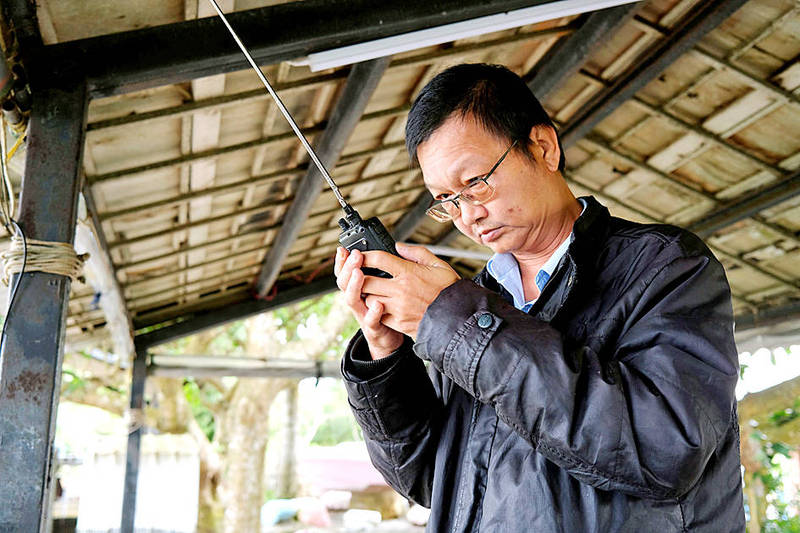《TAIPEI TIMES》 Radio enthusiasts share warnings to PLA warplanes

Radio enthusiast Robin Hsu monitors flight traffic from a cafe in Pingtung on May 3. Photo: Fabian Hamacher, Reuters
By Yimou Lee and Fabian Hamacher / Reuters, SYUHAI, Taiwan
Shortly after dawn on a southern Taiwanese beach, Robin Hsu’s (許耿睿) iPhone pings with the first radio message of the day from the air force as it warns away Chinese aircraft.
“Attention,” a voice says on the radio, speaking in Mandarin to a Chinese military plane flying at an altitude of 3,500m. “You have entered our southwestern air defense identification zone and are jeopardizing aviation safety. Turn around and leave immediately.”
Taiwan has complained for years of repeated Chinese air force missions into its air defense identification zone, which is not territorial airspace, but a broader area it monitors for threats.
Although the Ministry of National Defense details these almost-daily incursions on its Web site, including maps outlining the activity, a band of Taiwanese radio enthusiasts like Hsu has been tuning in to related radio traffic and publishing the recordings online.
“The Chinese communist planes are like flies on your dining table. If you kill them on your plate then your meal is ruined,” said Hsu, 50, a tour guide and military enthusiast. “All you can do is to wave them away.”
The action ebbs and flows. On one day this month, when reporters accompanied Hsu, nine other warnings were broadcast to Chinese warplanes after the one at dawn.
The Chinese aircraft have not fired a shot and have not come near Taiwan’s shores, the military has said.
However, the incursions amount to a low-key war of attrition, as the nation frequently scrambles aircraft to intercept Chinese planes.
The ministry has termed the flights “gray zone” tactics, designed to exhaust its air defenses physically and financially.
Halfway through lunch, Hsu’s iPhone — which is linked to a separate radio antenna — tracked another broadcast, this time in English.
“Chinese Air Force, I am a United States aircraft operating in international airspace and exercising these rights as guaranteed by international law,” the transmission said. “I am operating with due regard to the rights and duties of all states.”
On a flight tracker app, a US military refueling plane was flying east off Taiwan’s southwest into the Bashi Channel that separates the nation from the Philippines.
A spokesperson for the US Indo-Pacific Command said that there are routine flights conducted in international airspace in accordance with international law and that the language in the broadcast is consistent with US military aviation units operating in the Indo-Pacific.
The same day, Taiwan scrambled jets to warn away six Chinese aircraft, including two H-6 bombers and one Y-8 anti-submarine aircraft, the ministry said.
The Chinese Ministry of Defense and its Taiwan Affairs Office did not respond to requests for comment.
Hsu and his team have set up a dozen reception points on hills across Taiwan. With the help of those stations and flight-tracking apps, Hsu has counted 317 Taiwan warnings to Chinese warplanes from the start of the year to early May, 3 percent more than in the same period a year earlier.
“I want people to know the Chinese communist planes are very close to us,” said Hsu, who releases his recordings on a Facebook page that has attracted nearly 16,000 followers and is widely tracked by Taiwanese media.
He said that making such information public could boost support for Taiwan’s armed forces, which are dwarfed by China’s.
Taiwan’s defense ministry said that it respects any opinion that helps boost defense, but had no further comment.
On rare occasions, Chinese pilots have responded to Taiwan’s radio communications.
“This is China’s People’s Liberation Army [PLA]. I am conducting routine exercises. Please do not interrupt my activities,” one message in Mandarin said in late 2020, minutes after Taiwan warned away a Chinese warplane.
Hsu, a former navy radar operator, described a pattern of activities off Taiwan’s southwest in which US military planes, often refueling and surveillance aircraft, are shadowed by Chinese planes, who are warned away.
Military experts say that the strategic waters, where the largely shallow Taiwan Strait descends in depth, provide submarines a location for an ambush, drawing anti-submarine and surveillance aircraft.
Su Tzu-yun (蘇紫雲), a research fellow at the Institute for National Defense and Security Research, said that Hsu’s efforts help the public understand that the threat from China is “very real and immediate.”
The transparency could also help both militaries avoid an accidental conflict, Su said.
At one of his reception points, a hilltop cafe overlooking the Taiwan Strait, Hsu said he planned to expand his network to include communications in Taiwan’s northern skies, where the air forces of Taiwan, Japan and China regularly cross paths.
“On the surface, we have peace, but the reality is Chinese communist planes are flying on our doorstep every day,” he said. “People need to be aware of the crisis.”
新聞來源:TAIPEI TIMES












